Menus
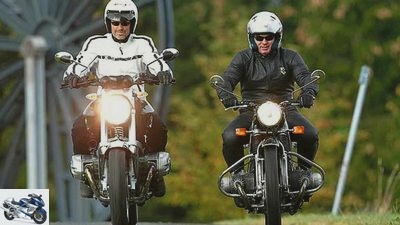
Gargolov
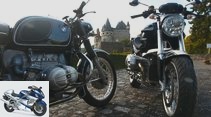



14th photos
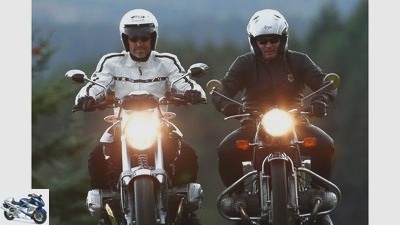
Gargolov
1/14
Two BMWs in a generation comparison: R 1200 R Classic and R 75/5.
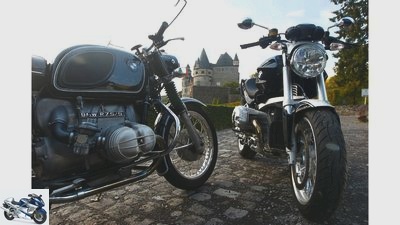
Gargolov
2/14
BMW R 75/5 and R 1200 R Classic.

Gargolov
3/14
BMW R 75/5.

Gargolov
4/14
BMW R 75/5.
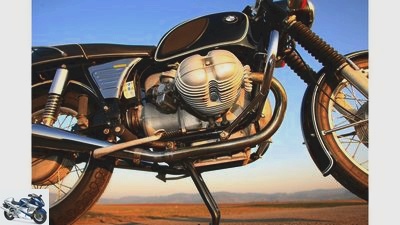
Gargolov
5/14
Form follows function: clear, straightforward lines of engine and gearbox.
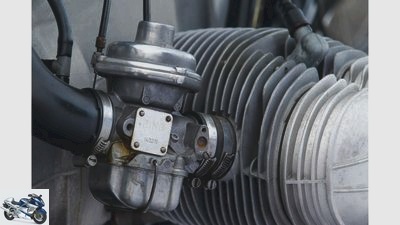
Gargolov
6/14
In the R 75/5, Bing constant pressure carburettors prepare the mixture.
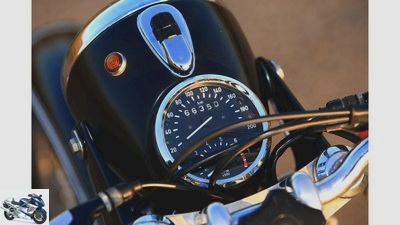
Gargolov
7/14
BMW R 75/5: The tachometer integrated in the speedometer was mostly covered by Bowden cables. Lonely: the charge indicator light in the lamp housing.
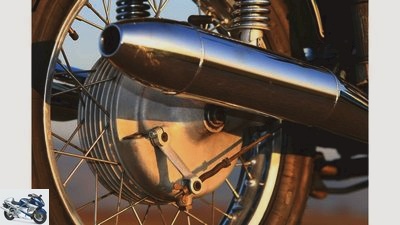
Gargolov
8/14
If the chrome of the silencer shows bulges, the rust gnaws inside. A simplex drum brake is sufficient on the rear wheel.

Gargolov
9/14
BMW R 75/5 – Effect of the duplex brake: “available”.
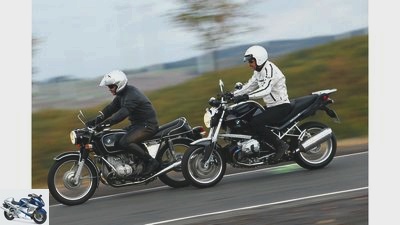
Gargolov
10/14
BMW R 75/5 and R 1200 R Classic.
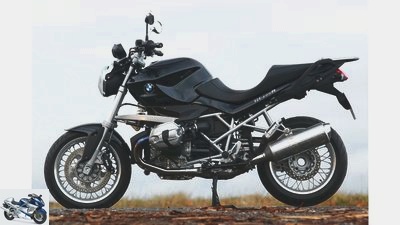
Gargolov
11/14
BMW R 1200 R Classic.
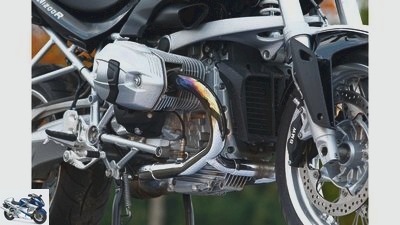
Gargolov
12/14
BMW R 1200: Two timing chains each drive two overhead camshafts per cylinder. They operate four valves per cylinder via rocker arms.
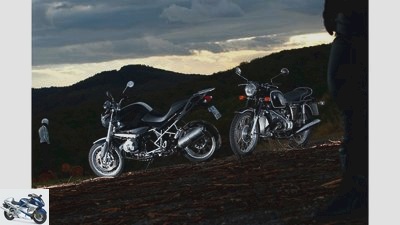
Gargolov
13/14
BMW R 1200 R Classic and R 75/5.
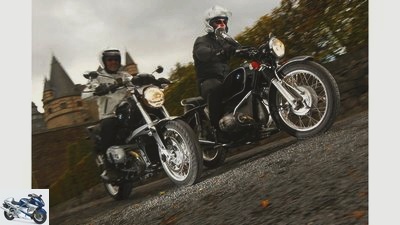
Gargolov
14/14
BMW R 1200 R Classic and R 75/5.
On the move: BMW R 75/5 and BMW R 1200 R Classic
The boxer generation comparison
Content of
If committed BMW employees hadn’t punched through new boxer models in the 60s, there would probably be no white-and-blue two-cylinder engines like the R 1200 R today. A comparison of the generations.
At the end of the 1960s, the performance-oriented motorcyclist clientele experienced a memorable departure into a new era. Honda undoubtedly made the hit in 1969 with the presentation of the CB 750. In the same year, Kawasaki presented a completely different concept and launched an uncompromising two-stroke rocket for sports drivers with the 500 H1 Mach III. The year before, Triumph and BSA had caused a sensation with their three-cylinder engines, and in Italy MV Agusta made a name for itself with the 750 S and Moto Guzzi with the 750 Sport.
F.The time for a new series of boxer models was overripe for BMW, because the two-cylinder swing arm models R 50 and R 60 had remained in the range almost unchanged since 1956. Finally, in 1960, the R 50 S and R 69 S variants were added. But the boxer with roller bearings had reached its limits in terms of performance and stability. For years, die-hard BMW fans have been waiting eagerly for innovations from Munich. Technology-oriented motorcycle enthusiasts even dared to dream of finesse such as king-shaft driven, overhead camshafts and a central bearing of the crankshaft.
But the expectations were decidedly too high – given the uncertain situation of the motorcycle market in general and the motorcycle division in Munich in particular. And not because the developers were asleep, but because they were waging a struggle for the survival of the white-blue two-wheelers, which was not lost thanks to exports and international government contracts alone. Considerations to stop motorcycle production came from the highest level in the group. A few enthusiasts such as test leader Hans Gunther von der Marwitz or the technical director of BMW, Helmut Werner Bonsch, an ardent proponent of the two-wheeler idea, were pretty much alone in-house and fought with great commitment to ensure the continued existence of the once glorious motorcycle production. In some cases, new ideas were developed in the quiet room of the test department, which those responsible initially had no idea of. As early as 1963, the first test vehicle of the internally named 246 project with a completely redesigned chassis and R 69 S engine was created, which made its first public appearance almost incognito in 1964 during a two-day off-road trip in Eschwege.
In view of the critical situation on the motorcycle market – BMW only sold 723 motorcycles in Germany in 1968 – the presentation of the new series in autumn 1969 with the models R 50/5, R 60/5 and R 75/5 represented a minor sensation, too when the technology turned out to be rather conservative compared to the competition. The increased output of the top model R 75/5 compared to the R 69 S resulted primarily from the increase in displacement to 750 cm³. With 50 hp at 6200 rpm, it was in the lower range in an international comparison of the new models.
Gargolov
BMW R 1200 R Classic and R 75/5.
And despite the conceptual similarity to the predecessor, the developers had put a completely new design on the wheels, which also offered some potential for the future. The base of the engine was again a tunnel housing. The central camshaft, now placed under the crankshaft, operated the valves via long bumpers and rocker arms, as in the previous models. The cylinders have recently been made of an aluminum alloy. The forged and much stiffer crankshaft with plain bearings promised significantly greater stability and smoother running. Of course, the new generation engine started with an electric starter. Innovative Bing constant pressure carburettors prepared the mixture in the R 75/5. As in the previous series, the redesigned transmission had four gears. The double loop frame, partly with conically drawn tubes, was at best still visually related to the previous models. The telescopic fork with its lush 214 millimeters of spring travel, which had been built into the US models since 1967, undoubtedly caught the eye. And the fenders made of fiberglass-reinforced plastic were considered highly advanced.
Thanks to the many innovations – not only BMW drivers were eagerly awaiting the first driving report of the top model R 75/5. In the 18/1969 issue, MOTORRAD presented the brand new boxer down to the smallest detail and also provided an extensive driving report. And the Munich-based company placed a full-page ad with the clear announcement: “BMW is committed to motorcycles.” That was, at least from the two-wheeler department, not just intended as lip service.
The driving report from Ernst Leverkus, of course with a tachograph and also of course on the Nordschleife, was extremely positive. On the one hand, “no brainer” thought that 50 PS was a “lucky value” for a solo machine, and on the other hand, he was already speculating on an “S model for people who are particularly committed to sport”, a wish that BMW was to fulfill a few years later with the R 90 S. . He was full of praise for the chassis: “The chassis is the most remarkable among all the other details”. But not all customers shared this opinion. The tendency to pendulum in the area of the top speed, especially with suitcases, and the strong reactions of the cardan drive gave the R 75/5 the not very laudable image of the “rubber cow”. BMW only reacted to the complaints in 1973 and lengthened the rear swing arm, and thus the wheelbase, by a whopping 50 millimeters, which resulted in a significant reduction in cardan reactions and increased driving stability. A measure that appeared to be urgently needed in view of the future expansion of the cubic capacity to 900 and later 1000 cm³.
Gargolov
BMW R 75/5 and R 1200 R Classic.
In general, the boxer experienced constant further development in terms of its range of uses. The R 90 S sports model came in 1973, followed by the fully faired R 100 RS sports tourer in 1977, now with the full liter displacement, and in 1978 the R 100 RT supertourer. In 1980 BMW presented a new concept that was to write a success story that continues to this day, the large enduro R 80 G / S. The two-valve boxer in the R 80 GS Basic remained in the range until 1997 and thus retired 29 years after the debut of the / 5 series. In the meantime, the K models with in-line three and four-cylinder engines had long since found their way into series production. And a new boxer engine followed in the footsteps of the aged two-valve engine in 1993. With 1100 cm³, injection, four valves per cylinder, actuated by a half-height camshaft in the cylinder head and short tappets, the engine largely corresponded to the state of the art. That was especially true for the chassis. BMW had already introduced the Paralever two-joint single-sided swing arm in the old series, which eliminated the cardan reactions.
The two-valve engine retired 29 years after its debut. With the four-valve boxer, the Telelever front suspension was introduced, which not only shone with its particularly sensitive response, but also minimized the amount of immersion in the telescopic fork when braking.
After all, the four-valve engine was in service for 17 years until the current boxer replaced it in 2010. The displacement increased further to 1200 cm³. Two overhead camshafts now control four valves per cylinder. The specialty: one of the two camshafts per cylinder actuates both an inlet and an outlet valve.
A generous 43 years lie between the first R 75/5 and the current R 1200 R Classic, almost as much as the span that elapsed between the introduction of the first BMW, the R 32 from 1923 and the R 75/5. The oldtimer looks almost dainty next to the new one. Clear lines and shapes dominate the look of the old ones, the design of the R 1200 R, on the other hand, appears rugged. In direct comparison to the classic telescopic fork and the two-arm swing arm of the R 75, their chassis with Tele and Paralever appears almost futuristic. Of course, such an abundance of innovations takes its toll. At 237 kilograms, the R 1200 R weighs a whopping 27 kilograms more than its ancestor, and its visual appearance alone inspires respect.
Once the driver is seated, this impression disappears. It sits enthroned in the seat recess of the 1200s almost at the same height as on the level bench of the 75/5. The higher and wider handlebars of the R 1200 allow a relaxed sitting position with an upright upper body. The R 75, with its significantly narrower and lower handlebars, forces the upper body to bend slightly forward, which is by no means uncomfortable and appears more dynamic. Once in motion, the difference over 40 years becomes blatantly noticeable. 50 HP on the one hand and 110 HP on the other reveal worlds in terms of driving dynamics. The R 75 is rather sedate and doesn’t really appreciate high speeds. In the medium engine speed range, it kicks in vigorously, but above 5500 rpm the thrust decreases noticeably. Speeds up to the red area of the tachometer integrated in the speedometer are not the strong point of the bumper motor. And the gear changes in the four-speed transmission are neither silent nor nimble. Time is of the essence when switching.
Gargolov
Form follows function: clear, straightforward lines of engine and gearbox.
The R 1200 is completely different: the shifting of the six-speed gearbox is now playful and silent. In direct comparison, the current boxer presents itself as a barrel organ that does not shy away from speeds of up to 9000 rpm and acts as a dynamic miracle. There are worlds between the two engines when it comes to power delivery. And yet: the narrower the track, the better the oldtimer showcases itself and its outstanding handiness. The modern 1200 can also serve with good handiness, but does not come close to the maneuverability of the ancestor. But it shines with high driving stability up to its top speed of 220 km / h. Regardless of whether it is flush with the board or washboard, the chassis has everything under control and smoothly filters out almost all bumps.
In terms of comfort, the R 75 with the comfortably coordinated telescopic fork and the soft Boge spring struts is also at a high level, but cannot keep up with the driving stability of the R 1200. In addition, it reacts to load changes with the typical tilting around the longitudinal axis as well as clear vertical movements of the hindquarters. Both bad habits are alien to the new one. In spite of this, the R75 / 5 with the sensitively appealing telescopic fork set standards of comfort in its time compared to the international competition. When it comes to brakes, too, there is a world between new and old. With its duplex drum brake in the front wheel, the classic slows down dough and with a lot of hand force at best moderately. The four-piston fixed calipers in the front wheel of the 1200 series can be perfectly metered to ensure contemporary deceleration even with a slight pull on the hand lever, and thanks to ABS even up to the locking limit without any problems.
When it comes to purely subjective criteria such as sound, the R 75 scores again. Dull, boxer-typical sonorous hum accompanies the opening of the throttle valve. The R 1200 R, on the other hand, complies with the law, is less sonorous, and sometimes even very restrained in certain speed and load ranges.
Of course, the R 1200 R can do almost everything better. However, two things speak in favor of the classic. The playful handiness with which the R 75 operates makes it a motorcycle with a high fun factor on narrow, winding terrain. It also pleases with its sound and its look. The simple, clear lines of the R 75/5 are alien to the new R 1200 R. But it’s not all evening yet. With a new head of design at BMW Motorrad, a boxer with a retro design may one day appear, which not only bears the Classic label, but also takes up the clear lines of the R 75 and forms a synthesis of classic optics and modern technology – a concept that also comes up Most of the sworn boxer fans would want. Surveys by our sister magazine MOTORRAD with specific suggestions for a professionally designed retro model initiated a flood of letters to the editor with consistently positive feedback.




11 photos
Pictures: On the move: BMW R 75/5 and BMW R 1200 R Classic
To home page
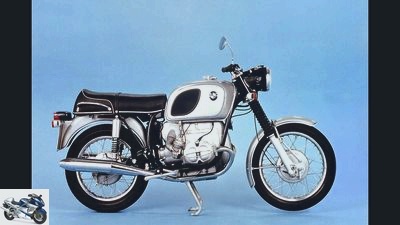
archive
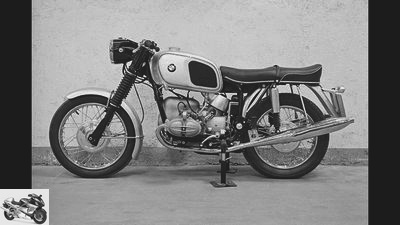
archive
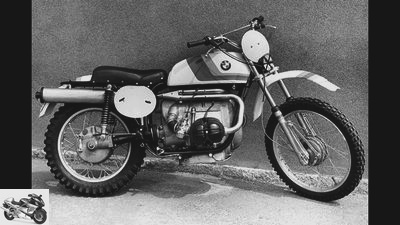
archive
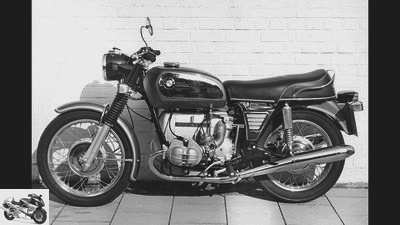
archive

archive
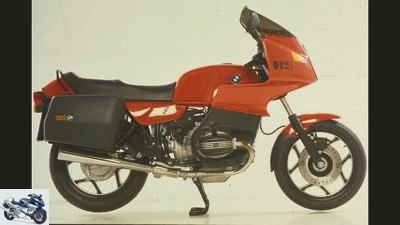
archive
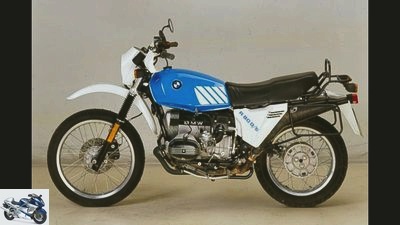
archive
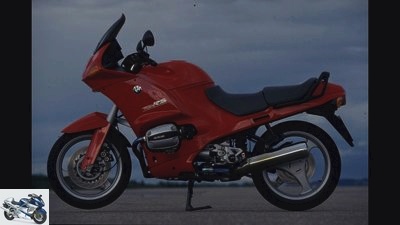
archive
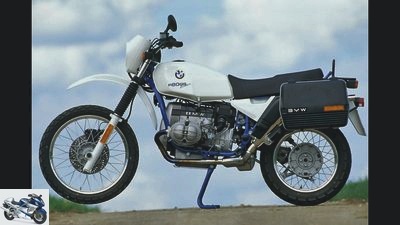
archive
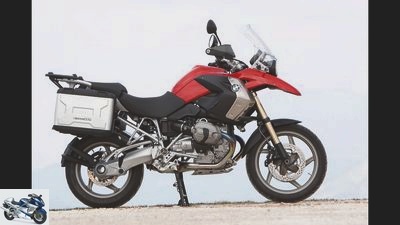
archive
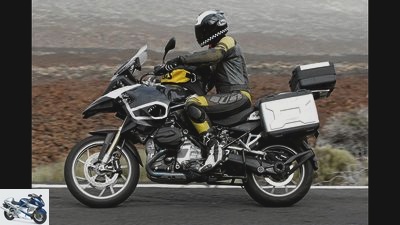
archive
In detail: BMW R 75/5
Gargolov
BMW R 75/5.
BMW R 75/5 (1969-1973), price 1969: 4996 marks
technology
In general, the technology of the BMW R 75/5 is solid, clear and comparatively easy to use. The suitability for everyday use is also above average. Thanks to the relaxed seating position, the large tank and the cardan drive, even long stages, especially with the 24-liter tank of the first series, can be easily mastered. In 1971 BMW had eliminated most of the teething problems with the clutch, electrics and carburetors. In the same year, a 17.5 liter tank replaced the first version, which was still available at an additional cost. Models with the extended and more torsion-resistant swing arm built from 1973 onwards are preferable to the first series due to their greater driving stability. However, even the first examples with modern tires such as Bridgestone BT 45 show impeccable handling.
Gargolov
BMW R 75/5: The tachometer integrated in the speedometer was mostly covered by Bowden cables. Lonely: the charge indicator light in the lamp housing.
Used check
First and foremost, the original condition of the / 5 models is decisive. Conversions reduce the value considerably. Serious weak points are alien to the BMW R 75/5. The engine and gearbox are robust and usually last up to 80,000 kilometers without complaint. Oil mist can then occur at the joint between the engine and the gearbox. You should therefore check the area of the oil pan extended to the rear. If oil leaks, both the rear crankshaft oil seal or the gear oil seal can be worn. In extreme cases, hairline cracks can even occur in the motor housing. The sleeve, which is supposed to protect the universal joint, is usually still the original part, has hardened accordingly and should definitely be replaced. Further neuralgic points after high mileage are the teeth in the driver of the rear wheel and the universal joint of the cardan. However, an exact diagnosis is only possible by dismantling the corresponding modules. The alternator armatures also sometimes burn out. If the charge control lamp does not come on when the ignition is switched on, a repair is required.
market
The range of R 75/5 is still relatively wide, the selection good and the prices therefore manageable. Most of the offers are in their original state. The mileage averages 50,000 kilometers. In good condition, such models cost between 4000 and 5500 euros. Even partially restored machines with lower mileage are on offer for 6,000 euros. The lower end of the price range is 3500 euros. Thanks to the large selection, it is worth making an extensive comparison.
Clubs and forums
BMW Club Germany e. V.
Tel .: 066 31/706 07 70,
www.bmw-club.de
Gargolov
BMW R 75/5.
BMW R 75/5 model 1969
engine:
Air-cooled two-cylinder four-stroke boxer engine, a central camshaft, two valves per cylinder, operated via bumpers and rocker arms, bore x stroke 82.0 x 70.6 mm, displacement 746 cm³, constant pressure carburetor, Ø 32 mm
power:
50 hp at 6200 rpm
Torque:
60 Nm at 5000 rpm
Power transmission:
Single-disc dry clutch, four-speed gearbox, cardan drive
landing gear:
Double loop frame made of tubular steel, telescopic fork at the front, Ø 36 mm, two-arm swing arm at the rear, two spring struts, spoke wheels with aluminum rims, tires 3.25 S 19 at the front, 4.00 S 18 at the rear, duplex drum brake at the front, Ø 200 mm, simplex drum brake at the rear, Ø 200 mm,
measurements and weight:
Wheelbase 1385 mm (from 1973 1435 mm), weight 210 kg with a full tank
Mileage:
Top speed 175 km / h
price:
4996 Mark (1969)
Gargolov
BMW R 1200 R Classic.
BMW R 1200 R Classic model 2011
engine:
Air / oil-cooled two-cylinder four-stroke boxer engine, two overhead camshafts per cylinder, four valves per cylinder, operated via rocker arms, bore x stroke 101.0 x 73.0 mm, displacement 1170 cm³, injection, Ø 50 mm
power:
110 hp at 7750 rpm
Torque:
119 Nm at 6000 rpm
Power transmission:
Single-disc dry clutch, six-speed gearbox, cardan drive
landing gear:
Tubular tubular steel frame, longitudinal control arm-supported telescopic fork at the front, two-jointed single-sided swing arm at the rear, central spring strut, spoked wheels with aluminum rims, tires 120/70 ZR 17 at the front, 180/55 ZR 17 at the rear, double disc brakes at the front, four-piston fixed calipers, disc brakes at the rear
measurements and weight:
Wheelbase 1495 mm, weight with a full tank 237 kg
Mileage:
Top speed 220 km / h
price:
12,660 euros
Related articles
-
BMW R 1200 R Classic and Ducati Monster 1100 Evo in comparison
Jahn 18 pictures Jahn 1/18 The BMW R 1200 R Classic and the Ducati Monster 1100 Evo will both still be powered by air / oil-cooled engines, …
-
Driving report: BMW R 1200 R Classic
fact 22 pictures BMW 1/22 BMW R 1200 R: Stainless steel exhaust system with additional chrome plating. The Classic gets it as standard, for the standard R …
-
Comparison: BMW R 75-5 and R 1200 R Classic – motorcycle myths
Gargolov BMW R 75/5 in comparison with the R 1200 R Classic Yesterday and today BMW has been building air-cooled two-cylinder boxer motorcycles since 1923. Looks …
-
New products: BMW R 1200 RT model presentation
BMW model presentation: New product BMW R 1200 RT Traditionally modern The RT models from BMW were not the first to introduce new technical solutions …
-
BMW R 1200 R in the HP driving report
32 pictures 1/32 BMW R 1200 R. Manufacturer 2/32 BMW R 1200 R. Manufacturer 3/32 BMW R 1200 R. 4/32 BMW R 1200 R ….
-
Comparative test BMW K 1200 LT, Harley-Davidson Electra Glide Ultra Classic, Yamaha XVZ 13 TF Royal Star Venture Beautiful living Eating kilometers, for two, …
-
Driving report: BMW R 1200 C The desert is shaking In the barren landscape of the US state of Arizona, BMW presented the cruiser R 1200 C a few days ago ….
-
fact Top test BMW R 1200 S The new S The R 90 S and R 100 S tried to establish the S as the epitome of sport in the BMW range. But only the R 1100 S,…
-
BMW R nineT and BMW R 1200 R in the test
www. 39 Pictures www. 1/39 When the R 1200 R drives off, the eyes stay on the R nineT, if it rolls up, all eyes follow it. So…
-
Gargolov 32 pictures Gargolov 1/32 BMW R 32 and BMW R 1200 GS – BMW boxers then and now. Gargolov 2/32 BMW R 32 and BMW R 1200 GS – BMW boxers once and …